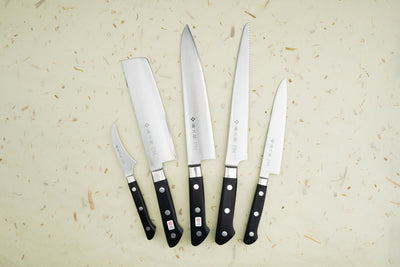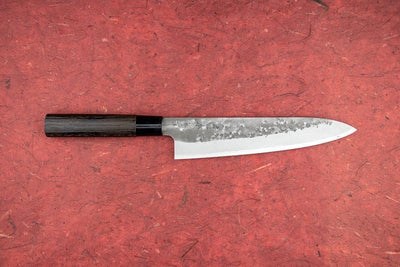
The Best Japanese Kitchen Knives for Professional Cooks and Chefs
I was a chef for a long time, and I used many Japanese knives throughout my career. I did everything from artisanal Japanese cuisine to dive bars, and I learned a thing or two about hard-working knives along the way.
Often, we industry folk want slightly different things from our knives than a typical home user. We want the tool to get sharp quickly and stay sharp for a long time; nobody wants to be the FNG (F**** New Guy) who bruises the chives. We want easy maintenance for when service gets a little too hot, and sometimes we need a simple-looking knife, so the shady new cook doesn’t walk out the door with it. If you’re getting paid what I used to, money’s probably a little tight, too. Sure, a gorgeous, fully hand-forged damascus knife with generations of history would be nice, but let’s cut to the chase: how’s it going to work in the most demanding circumstances?
The Chef’s Knife (Gyuto) - Your main kitchen knife
A chef’s heart lives in their best chef knife, not their chest. This is the knife you want to spend the most money on because you will be using it day in and day out. Pick up a 240mm gyuto. Pros will have the skills to wield a blade this big and let’s face it, anything smaller won’t cut it for that 10lbs of slaw you’re prepping or that sack of onions calling your name.
 A reliable gyuto is the back-bone of any chef's kit.
A reliable gyuto is the back-bone of any chef's kit.
I recommend stainless steel for your first Japanese knife. You never know when you’re going to rush away to dig the commis on garmo out of the weeds. You don’t want to come back to find those lemons have left a fresh coat of rust on your brand new knife.
My first real knife was a Tojiro Classic gyuto, and it was perfect for me as a green cook. This knife outperforms its relatively low price tag and has no frills. You get the most reliable tool anyone could ask for. It doesn’t have the screaming sharpness of a laser or the almost frightening edge retention of the powdered stainless steel, but it will say a firm “Yes Chef!” to any job you ask of it.
Another favourite is the Mikuri Ume. These come in both western and Japanese handles, and are razor sharp yet rugged, so you won't wince when your dishwasher picks it up to cut a case of onions. You can drive them hard and they'll just keep going!
So you think you can handle a little maintenance and want to see what this carbon steel is all about? The Fujimoto Nashiji knives are the best starting point for forged carbon steel. You’ll need to dry it off right away, but the stainless steel cladding gives you a little wiggle room before they rust. The finishing, while beautiful, is all done to keep the price relatively low. And boy does this knife cut. There’s nothing like the edge on a well-made carbon steel knife, and it’s easier to keep carbon sharper for longer using a ceramic honing rod.
The Petty 150 or Utility Knife - Your secondary knife
Some of the kitchens I used to work in were so small that rubbing butts was the norm. In spaces like this, it’s unrealistic to use a gyuto the size of your cutting board for everything. Many jobs require a little more finesse; say you need to segment a few oranges for that fennel salad or quickly take some fat off a pork roast. This is when the Petty 150mm shape is perfect.
 Petty knives are great on the cutting board, but also in your hand for more precise jobs.
Petty knives are great on the cutting board, but also in your hand for more precise jobs.
I have to plug the Tojiro Classic here again. Like I said before, this is the entry-level workhorse and never disappoints. It doesn’t have the allure of something more handmade, but the steel is of excellent quality, and every dollar spent translates to a quality knife.
The Seki Kanetsugu Zuiun 150mm Petty is the dream knife for many cooks. These are lightweight and laser thin, made from crazy hard, hand-forged, powdered stainless steel. They're also incredibly sexy, and a great way to spoil yourself after a raise or promotion. With this knife, you’ll be begging the prep cooks to let you have a go at the bruschetta this week.
The Fujimoto Hammer Tone Petty may be a little shorter, but it's every bit as capable. These are made from semi-stainless steel, so you have some leeway to step away from your prep to get a quick bollocking from Chef, but you do need to dry it off eventually.
TL;DR: Get a Great Gyuto and a Stainless Petty
With those two knives and a ceramic honing rod, you have a small kit that can do anything from butchering the big chunk of beef to a fine brunoise of shallot or some squash for soup. Generally, stick to stainless steel—unless you’re very confident in your habits. Rene Redzepi once said, “Peace of mind is the most valuable thing in the world.” I happen to know that he uses Takamura knives and can personally vouch for the peace of mind that comes from knowing that whatever job comes my way, I’m prepared for it with a clean apron and a sharp knife. Check out our selection here if you need a knife bag to put everything in. We also have a great blog by Nathan about rounding out the rest of your kit if you’re new to professional cooking. Now hurry up; we’ve got an eight-top coming in at 5:30, and I can tell your mise isn’t ready!








